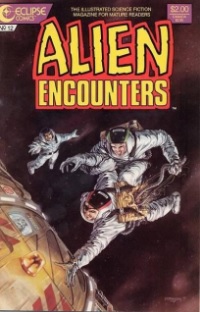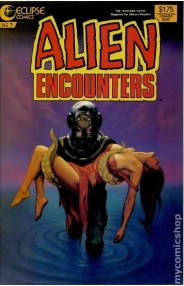Editor’s Note: This is a guest piece from a new contributor, Eric Onkenhout. He’s an expert in all things pulp and Star Wars and we hope to see more of his work around here. Without further ado, here is his review of pulp classic Alien Encounters.
I’m back with another review and this time it is for a comic series called Alien Encounters (1985-87) which was published by Eclipse Comics. They were one of several American independent comic publishers that existed during the 1980s and into the early 1990s. Unfortunately Eclipse had lost most of its back-issues in a flood in 1986, had eased operations in 1994, and by 1995 had filed for bankruptcy.
There’s a little history lesson before I proceed. Before Eclipse, there was another independent publisher called Pacific Comics that published titles like Alien Worlds and Vanguard Illustrated. By 1984, Pacific had liquidated and closed shop, and many of its artists had moved on to Eclipse. Eclipse Comics finished off the Alien Worlds series, then went on to publish comics like World of Wood (referring to Wally Wood, the famed comic artist/writer), and Alien Encounters.
Having read Alien Worlds, and really enjoying the stories told in there, I had high hopes. Unfortunately, the Alien Encounters series fell flat for me. It consisted of a 14 issue series, with one stand-alone issue in 3D which came with its own pair of 3D glasses (I’ll come back to this later).
Being an enthusiast of the pre-code era EC Comics of the 1950s (Weird Science and WeirdFantasy), I was excited to dive into these for the previous Alien Worlds were heavily inspired by said comics, and the covers were also inspired by another love of mine; pulp magazines.
It wouldn’t be extremely fair to compare comic trend setters like EC to anyone, but the science fiction then always had a message and was relevant to the times; I.E. nuclear war, communism, space race, Martian invasion. However, the stories in Alien Encounters seemed direction-less—often jumbled together with sub-par artwork that was difficult, at times, to follow panel to panel.
The stories themselves were a real drag to get through, so much that I often caught myself dozing off while reading them. The writing was forgettable. In fact, I could not tell you what a single story was about without referring back to an issue. Most consisted of characters dressed in 80s style punk rock get-ups. On the cover of each issue it states, “The Illustrated Science Fiction Magazine for Mature Readers”, but the amount of female characters illustrated topless made me think I was watching an episode of Game of Thrones without the actual good story-telling. It felt more like a bunch of guys got together to draw out their inner most fantasies; which makes it ironic that the publisher was a woman (Catherine Yronwode). I can’t blame them though; it was a period when most female characters were there just to be eye candy and not much else.

The lone stand out in the series was the cover art which I thought was decent—a couple issues (5 and 12) even featuring a younger Dave Dorman, who some might be familiar with for his work with the Star Wars Dark Horse series in the 90s.
Getting back to the 3D issue. After finishing the last issue, I was undecided on whether or not I should even bother with the 3D issue, but being the trooper that I try to be, I gave it a go…and lasted about 3 pages. I admit, it was a cool concept—reading a comic in 3D, but I gave up because I felt the eye strain coming, and I also noticed that some of the lettering was clear and not in 3D and some was blurry and illegible. Some of the panels stood out, and some didn’t. Which is unfortunate because the story featured a Rod Sterling type character called God Serling narrating a story about a young boy who traveled back in time to read old EC Comics.
As far as its attempt at mimicking EC’s social commentary, there were a few instances where it did reference the United States conflict with the Soviet Union and the threat of nuclear war, but not nearly enough in my opinion. And instead of possibly writing about a peaceful solution, or a common ground, or some kind of moral lesson, complete annihilation always seemed to be the answer.
Before I wrap this up I feel like I should balance out the scale a little and give you some more highlights. One particular story hit me hard and was very relevant to now. It came in issue 7 and was titled, So You Want to be in Pictures? It told the story of a woman, Elaine Campbell, who wanted to be an actress in movies. However, in order to be an actor she had to agree to give up the rights to her facial features. Basically they would copy her face and use it in any movie they wanted. For example, one movie producer commented that he had just seen “Bing Crosby in a porno flick”. In the story, the production crew would record her face expressing all sorts of emotions, and have her go through all these rigorous exercises, so they can have all this stock footage ready for when they make the film. I’m not sure, but I think they actually removed her face and replaced it with a generic version. There was no need for her actual body to be in the film.

Considering the recent passing of Carrie Fisher, and the scenes in Rogue One with Tarkin and Leia, this certain scene resounded with me. The dialogue went like this:
John Garmire, casting director for Metro Studios: “I’ve been watching you all night. You have the look we’ve been searching for for our next picture.”
Elaine Campbell: I’ve heard a lot of pick-up lines before, but don’t you think that one’s a bit dated? Everyone knows they don’t use real actors in movies anymore—it’s all computer generated.
Then later on:
John Garmire: Remember, you sold us exclusive rights to your image. It no longer belongs to you, and we cannot allow you to continue making unauthorized use of it—otherwise, by the legal principle of “easement”, we might lose our copyright to your image to the public domain.
In the end, unless you’re super into independent comic publishers and not the mainstream stuff, I’d avoid this series. To be honest, if you are into that stuff like I am, I’d highly recommend a series called Star Reach that was published in the 70s. It’s great stuff that I should probably revisit and review in the future.